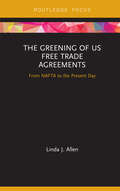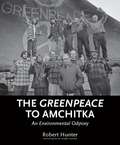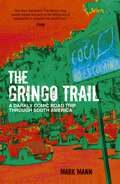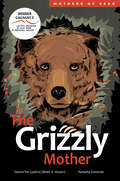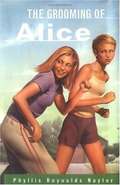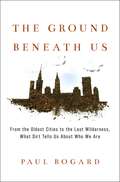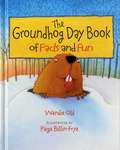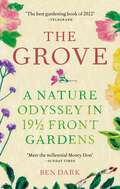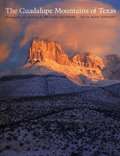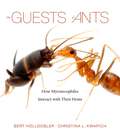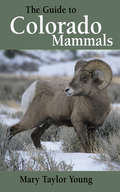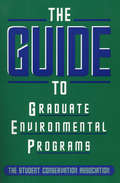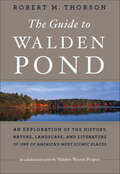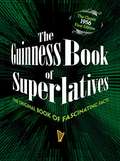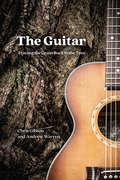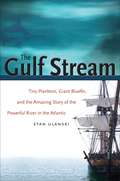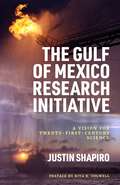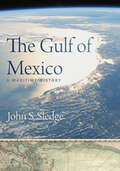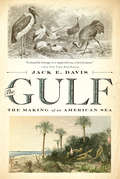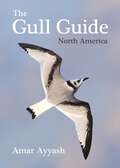- Table View
- List View
The Greening of US Free Trade Agreements: From NAFTA to the Present Day (Routledge Focus on Environment and Sustainability)
by Linda AllenThis book provides an up-to-date critical analysis of the integration of environmental policies into US free trade agreements. The work focuses on the evolution of the design of environmental policies and analyzes their effectiveness. Starting with the North American Free Trade Agreement (NAFTA) leading to the Trans-Pacific Partnership (TPP), the book examines the history of policy integration. In doing so, it provides an overview of the major trade-related environmental policies and presents empirical research on their effectiveness, a discussion of the continued demand for policy integration in light of the effectiveness, and recommendations for addressing shortcomings. The main objective of the book is to inform the ongoing policy debate over integration of environmental policies into trade agreements. The current renegotiation of NAFTA provides an opportune time for undertaking this critical review of trade-related environmental policies. As our understanding and knowledge of the environmental policies associated with US trade agreements, in particular for NAFTA, has grown significantly over the past twenty-five years, this book provides a timely and critical update for this policy debate. Students and scholars of environmental law, trade and economics, and specifically US trade, environmental policy and law will find this book of great interest.
The Greenpeace to Amchitka
by Robert Keziere Robert HunterGreenpeace is known around the world for its activism and education surrounding environmental and biodiversity issues. With a presence in more than 40 countries across Europe, the Americas, Asia and the Pacific, Greenpeace is undoubtedly a dominant force in the realm of environmental activism.This is the story of how Greenpeace came to be.In September 1971, a small group of activists boarded a small fishing boat in Vancouver, Canada, and headed north towards Amchitka, a tiny island west of Alaska in the Aleutian Islands, where the US government was conducting underground nuclear tests.At that time, protests against nuclear testing were not common, yet the US tests raised genuine concerns: Amchitka is not only the last refuge for endangered wildlife, but is also located in a geologically unstable region, one of the most earthquake-prone areas in the world. The threat of a nuclear-triggered earthquake or tsunami was real.Among the people sardined in the fishing boat were Robert Hunter and Robert Keziere.The boat, named the Greenpeace by the small group of men aboard, raced against time as it crashed through the Gulf of Alaska, braving the oncoming winter storms. Three weeks was all they had to reach Amchitka in an attempt to halt the nuclear test. Ultimately, the voyage--beset by bad weather, interpersonal tensions and conflicts with US officials--was doomed. And yet the legacy of that journey lives on.In this visceral memoir, based on a manuscript originally written over 30 years ago, Robert Hunter vividly depicts the peculiar odyssey that led to the formation of the most powerful environmental organization in the world.Features 40 black and white photographs taken during the voyage by Robert Keziere.
The Gringo Trail: A Darkly Comic Road Trip through South America
by Mark MannMark Mann and his girlfriend Melissa set off to explore the ancient monuments, mountains and rainforests of South America. But for their friend Mark, South America meant only one thing: drugs. Sad, funny and shocking, The Gringo Trail is a darkly comic road-trip and a revealing journey through South America’s turbulent history.
The Grizzly Mother (Mothers of Xsan)
by Hetxw’ms Gyetxw HusonBook two in the award-winning Mothers of Xsan series, The Grizzly Mother uses striking illustration and lyrical language to bring the poetry of the Xsan ecosystem to life.To the Gitxsan people of Northwestern British Columbia, the grizzly is an integral part of the natural landscape. Together, they share the land and forests that the Skeena River runs through, as well as the sockeye salmon within it. Follow mother bear as she teaches her cubs what they need to survive on their own.
The Grizzly Mother (Mothers of Xsan)
by Hetxw’ms Gyetxw HusonBook two in the award-winning Mothers of Xsan series, The Grizzly Mother uses striking illustration and lyrical language to bring the poetry of the Xsan ecosystem to life.To the Gitxsan people of Northwestern British Columbia, the grizzly is an integral part of the natural landscape. Together, they share the land and forests that the Skeena River runs through, as well as the sockeye salmon within it. Follow mother bear as she teaches her cubs what they need to survive on their own.
The Grooming of Alice (Alice McKinley #12)
by Phyllis Reynolds NaylorDuring the summer between eighth and ninth grades. Alice and her friends Pamela and Elizabeth decide to improve themselves through exercise.
The Ground Beneath Us: From the Oldest Cities to the Last Wilderness, What Dirt Tells Us About Who We Are
by Paul BogardOur most compelling resource just might be the ground beneath our feet. When a teaspoon of soil contains millions of species, and when we pave over the earth on a daily basis, what does that mean for our future? What is the risk to our food supply, the planet's wildlife, the soil on which every life-form depends? How much undeveloped, untrodden ground do we even have left?Paul Bogard set out to answer these questions in The Ground Beneath Us, and what he discovered is astounding.From New York (where more than 118,000,000 tons of human development rest on top of Manhattan Island) to Mexico City (which sinks inches each year into the Aztec ruins beneath it), Bogard shows us the weight of our cities' footprints. And as we see hallowed ground coughing up bullets at a Civil War battlefield; long-hidden remains emerging from below the sites of concentration camps; the dangerous, alluring power of fracking; the fragility of the giant redwoods, our planet's oldest living things; the surprises hidden under a Major League ballpark's grass; and the sublime beauty of our few remaining wildest places, one truth becomes blazingly clear: The ground is the easiest resource to forget, and the last we should.Bogard's The Ground Beneath Us is deeply transporting reading that introduces farmers, geologists, ecologists, cartographers, and others in a quest to understand the importance of something too many of us take for granted: dirt. From growth and life to death and loss, and from the subsurface technologies that run our cities to the dwindling number of idyllic Edens that remain, this is the fascinating story of the ground beneath our feet.
The Groundhog Day Book of Facts and Fun
by Wendie C. OldThis book of facts and fun provides plenty of information about groundhogs and the origin of Groundhog Day. Groundhog riddles and ideas for throwing a Groundhog Day party are included.
The Grove: A Nature Odyssey in 19 ½ Front Gardens
by Ben Dark***'Ben Dark is such a wonderful writer - The Grove drew me in from the first line.' Lia Leendertz'The Grove is overflowing with delicious nuggets of cultural, social and garden history - and I adore Ben Dark's humour and humility in equal measure.' Advolly Richmond'A heartfelt romp through the wisteria and wilderness of London's horticulturally remarkable front gardens.' Jack Wallington'Fans of Ben Dark's mellifluous tones on The Garden Log podcast will be delighted by how perfectly his lyrical musings transfer to the printed page as, with infant son in tow, he invites the reader upon a series of horticultural expeditions inspired by the deceptively ordinary planting of the front gardens in a south London street. The kind of thoroughly enjoyable read where you realise, late in the day, that learning has snuck in by the back door, though you feel inclined to forgive the author on account of the fun you've had along the way.'Andrew O'Brien'Any walk is an odyssey when we connect with the plants around us. Each tree or flower tells a tale. Mundane 'suburban' shrubs speak of war and poetry, of money, fashion, love and failure. Every species in this book was seen from one pavement over twelve months and there is little here that could not be found on any road in any town, but they reveal stories of such weirdness, drama, passion and humour that, once discovered, familiar neighbourhoods will be changed forever.' Ben DarkThere is a renewed interest in the nature on our doorsteps, as can be seen in the work of amateur botanists identifying wildflowers and chalking the names on the pavements.But beyond the garden wall lies a wealth of cultivated plants, each with a unique tale to tell. In The Grove, award-winning writer and head gardener Ben Dark reveals the remarkable secrets of twenty commonly found species - including the rose, wisteria, buddleja, box and the tulip - encountered in the front gardens of one London street over the course of year. As Ben writes, in those small front gardens 'are stories of ambition, envy, hope and failure' and The Grove is about so much more than a single street, or indeed the plants found in its 19 ½ front gardens. It's a beguiling blend of horticultural history and personal narrative and a lyrical exploration of why gardens and gardening matter.
The Grove: A Nature Odyssey in 19 ½ Front Gardens
by Ben Dark***'Ben Dark is such a wonderful writer - The Grove drew me in from the first line.' Lia Leendertz'The Grove is overflowing with delicious nuggets of cultural, social and garden history - and I adore Ben Dark's humour and humility in equal measure.' Advolly Richmond'A heartfelt romp through the wisteria and wilderness of London's horticulturally remarkable front gardens.' Jack Wallington'Fans of Ben Dark's mellifluous tones on The Garden Log podcast will be delighted by how perfectly his lyrical musings transfer to the printed page as, with infant son in tow, he invites the reader upon a series of horticultural expeditions inspired by the deceptively ordinary planting of the front gardens in a south London street. The kind of thoroughly enjoyable read where you realise, late in the day, that learning has snuck in by the back door, though you feel inclined to forgive the author on account of the fun you've had along the way.'Andrew O'Brien'Any walk is an odyssey when we connect with the plants around us. Each tree or flower tells a tale. Mundane 'suburban' shrubs speak of war and poetry, of money, fashion, love and failure. Every species in this book was seen from one pavement over twelve months and there is little here that could not be found on any road in any town, but they reveal stories of such weirdness, drama, passion and humour that, once discovered, familiar neighbourhoods will be changed forever.' Ben DarkThere is a renewed interest in the nature on our doorsteps, as can be seen in the work of amateur botanists identifying wildflowers and chalking the names on the pavements.But beyond the garden wall lies a wealth of cultivated plants, each with a unique tale to tell. In The Grove, award-winning writer and head gardener Ben Dark reveals the remarkable secrets of twenty commonly found species - including the rose, wisteria, buddleja, box and the tulip - encountered in the front gardens of one London street over the course of year. As Ben writes, in those small front gardens 'are stories of ambition, envy, hope and failure' and The Grove is about so much more than a single street, or indeed the plants found in its 19 ½ front gardens. It's a beguiling blend of horticultural history and personal narrative and a lyrical exploration of why gardens and gardening matter.
The Growth Spiral: Money, Energy, and Imagination in the Dynamics of the Market Process
by Hans Christoph BinswangerThis book develops a new theory of the modern economy. Conventional economic theory is (still) based on an essentially static notion of equilibrium. In contrast, this book offers an analysis of the economic process based on a truly dynamic approach. It understands modern economic activity as manifesting itself in a growth spiral. There are two main drivers of the dynamics of this spiral: steady money creation in the banking system, on the one hand; and the continuous inflow of energy and raw materials through the exploitation of natural resources, on the other. Both driving forces are generally neglected by the conventional theory. Understanding their role is absolutely essential for preventing our economy from being more and more exposed to financial and ecological crises. This book offers important insights about the functioning of the modern economy and addresses the specialist as well as the interested lay reader.
The Guadalupe Mountains of Texas
by Alan Tennant Larry Henderson Michael AllenderSince its publication in 1980, The Guadalupe Mountains of Texas has received many honors, including the Friends of the Dallas Public Library Award from the Texas Institute of Letters and recognition for its superb design from the Rounce and Coffin Club.
The Guests of Ants: How Myrmecophiles Interact with Their Hosts
by Bert Hölldobler Christina L. KwapichA fascinating examination of socially parasitic invaders, from butterflies to bacteria, that survive and thrive by exploiting the communication systems of ant colonies. Down below, on sidewalks, in fallen leaves, and across the forest floor, a covert invasion is taking place. Ant colonies, revered and studied for their complex collective behaviors, are being infiltrated by tiny organisms called myrmecophiles. Using incredibly sophisticated tactics, various species of butterflies, beetles, crickets, spiders, fungi, and bacteria insert themselves into ant colonies and decode the colonies’ communication system. Once able to “speak the language,” these outsiders can masquerade as ants. Suddenly colony members can no longer distinguish friend from foe. Pulitzer Prize–winning author and biologist Bert Hölldobler and behavioral ecologist Christina L. Kwapich explore this remarkable phenomenon, showing how myrmecophiles manage their feat of code-breaking and go on to exploit colony resources. Some myrmecophiles slip themselves into their hosts’ food sharing system, stealing liquid nutrition normally exchanged between ant nestmates. Other intruders use specialized organs and glandular secretions to entice ants or calm their aggression. Guiding readers through key experiments and observations, Hölldobler and Kwapich reveal a universe of behavioral mechanisms by which myrmecophiles turn ants into unwilling servants. As The Guests of Ants makes clear, symbiosis in ant societies can sometimes be mutualistic, but, in most cases, these foreign intruders exhibit amazingly diverse modes of parasitism. Like other unwelcome guests, many of these myrmecophiles both disrupt and depend on their host, making for an uneasy coexistence that nonetheless plays an important role in the balance of nature.
The Guide to Colorado Mammals
by Mary Taylor YoungMary Taylor Young's latest field guide will help you discover and learn more about Colorado's native mammals. Covering 128 species, this guide explores mammals through detailed descriptions, full-color photographs, and informative sidebars. Also includes range maps, species' descriptions, a checklist, and a glossary. Outdoor enthusiasts and armchair naturalists will be delighted with this guide.Award-winning nature writer Mary Taylor Young's love of wild things led to a degree in zoology and a life devoted to nature and the environment. She has written nine books, including The Guide to Colorado Reptiles and Amphibians. Taylor Young lives in Castle Rock, Colorado.
The Guide to Graduate Environmental Programs
by Scott D. IzzoThe Guide to Graduate Environmental Programs provides over 160 profiles of graduate programs across the country that offer curricula related to the environment. Following is a description of how the book was researched and the profiles compiled: The research process began with a list, drawn up by career center staff at University of California at Santa Barbara, of 412 environmental programs, departments, and schools within universities across the country. The list was based on a literature search, queries over the Internet, and contact with environmental professionals and associations. Certificate-only programs were not included. Selection preference was given to programs mentioned repeatedly by environmental professionals, and to those drawing a more diverse student body. Of the 412 graduate programs queried, 156 programs completed and returned their surveys. Each completed survey was reworked into a profile. Schools that did not respond to the mailing were contacted twice by phone to remind them to return the survey. To supplement this information, and to ensure that the most noteworthy programs were included in the guide, additional profiles were compiled for a select number of key programs that failed to return their surveys. These latter profiles were based on literature review and personal interviews. Most of the information provided was accurate as of November 1994 - the date by which the surveys were completed - and some follow-up verification was conducted during the summer of 1996, before the book went into production. There are an ever-expanding number of programs in the environmental field, and existing programs are constantly evolving. Readers should therefore expect to continue to encounter ongoing changes in names, titles, and phone numbers.
The Guide to Walden Pond: An Exploration of the History, Nature, Landscape, and Literature of One of America's Most Iconic Places
by Robert M. ThorsonAn exploration of the history, nature, landscape, and literature of one of America&’s most iconic places This is the first guidebook to Henry David Thoreau&’s most defining place, visited by half a million people each year and widely known as the fountainhead of America's environmental consciousness. Using this guide, both armchair readers and trail-walkers alike can amble around the pond&’s shoreline, pausing at fifteen special places to learn about people, historic events, and the natural world. Thoreau will be a constant companion via quotes from Walden. Stop by stop, the place of his book will merge with the book of his place. Abundantly illustrated with photographs, drawings, and maps, this guide is a must-have for a meaningful, engaging tour of Walden Pond as well as a souvenir of a visit. Special Thanks Concord Free Public Library Concord Museum Massachusetts Department of Conservation and Recreation Thoreau Farm Trust Thoreau Society Walden Woods Project
The Guinness Book of Superlatives: The Original Book of Fascinating Facts
by BooksImagine the world before Google or Facebook, when books were the only source of recorded fact. Originally published in 1956, The Guinness Book of Superlatives is the very first book in a series that would one day become one of the most well-known and trusted brands in the world—The Guinness Book of World Records. This is the original fun and informative edition, which gathered world facts and records from the year of its publication and prior. Included within are world records and facts from the sectors of: Science Politics Economics Art Architecture Engineering Accidents and disasters Human achievements The natural world And many more! Pick up this entertaining reference book, and expand your knowledge of the world as it was more than sixty years ago.
The Guitar: Tracing the Grain Back to the Tree
by Chris Gibson Andrew WarrenGuitars inspire cult-like devotion: an aficionado can tell you precisely when and where their favorite instrument was made, the wood it is made from, and that wood’s unique effect on the instrument’s sound. In The Guitar, Chris Gibson and Andrew Warren follow that fascination around the globe as they trace guitars all the way back to the tree. The authors take us to guitar factories, port cities, log booms, remote sawmills, Indigenous lands, and distant rainforests, on a quest for behind-the-scenes stories and insights into how guitars are made, where the much-cherished guitar timbers ultimately come from, and the people and skills that craft those timbers along the way. Gibson and Warren interview hundreds of people to give us a first-hand account of the ins and outs of production methods, timber milling, and forest custodianship in diverse corners of the world, including the Pacific Northwest, Madagascar, Spain, Brazil, Germany, Japan, China, Hawaii, and Australia. They unlock surprising insights into longer arcs of world history: on the human exploitation of nature, colonialism, industrial capitalism, cultural tensions, and seismic upheavals. But the authors also strike a hopeful note, offering a parable of wider resonance—of the incredible but underappreciated skill and care that goes into growing forests and felling trees, milling timber, and making enchanting musical instruments, set against the human tendency to reform our use (and abuse) of natural resources only when it may be too late. The Guitar promises to resonate with anyone who has ever fallen in love with a guitar.
The Guitar: Tracing the Grain Back to the Tree
by Chris Gibson Andrew WarrenGuitars inspire cult-like devotion: an aficionado can tell you precisely when and where their favorite instrument was made, the wood it is made from, and that wood’s unique effect on the instrument’s sound. In The Guitar, Chris Gibson and Andrew Warren follow that fascination around the globe as they trace guitars all the way back to the tree. The authors take us to guitar factories, port cities, log booms, remote sawmills, Indigenous lands, and distant rainforests, on a quest for behind-the-scenes stories and insights into how guitars are made, where the much-cherished guitar timbers ultimately come from, and the people and skills that craft those timbers along the way. Gibson and Warren interview hundreds of people to give us a first-hand account of the ins and outs of production methods, timber milling, and forest custodianship in diverse corners of the world, including the Pacific Northwest, Madagascar, Spain, Brazil, Germany, Japan, China, Hawaii, and Australia. They unlock surprising insights into longer arcs of world history: on the human exploitation of nature, colonialism, industrial capitalism, cultural tensions, and seismic upheavals. But the authors also strike a hopeful note, offering a parable of wider resonance—of the incredible but underappreciated skill and care that goes into growing forests and felling trees, milling timber, and making enchanting musical instruments, set against the human tendency to reform our use (and abuse) of natural resources only when it may be too late. The Guitar promises to resonate with anyone who has ever fallen in love with a guitar.
The Guitar: Tracing the Grain Back to the Tree
by Chris Gibson Andrew WarrenGuitars inspire cult-like devotion: an aficionado can tell you precisely when and where their favorite instrument was made, the wood it is made from, and that wood’s unique effect on the instrument’s sound. In The Guitar, Chris Gibson and Andrew Warren follow that fascination around the globe as they trace guitars all the way back to the tree. The authors take us to guitar factories, port cities, log booms, remote sawmills, Indigenous lands, and distant rainforests, on a quest for behind-the-scenes stories and insights into how guitars are made, where the much-cherished guitar timbers ultimately come from, and the people and skills that craft those timbers along the way. Gibson and Warren interview hundreds of people to give us a first-hand account of the ins and outs of production methods, timber milling, and forest custodianship in diverse corners of the world, including the Pacific Northwest, Madagascar, Spain, Brazil, Germany, Japan, China, Hawaii, and Australia. They unlock surprising insights into longer arcs of world history: on the human exploitation of nature, colonialism, industrial capitalism, cultural tensions, and seismic upheavals. But the authors also strike a hopeful note, offering a parable of wider resonance—of the incredible but underappreciated skill and care that goes into growing forests and felling trees, milling timber, and making enchanting musical instruments, set against the human tendency to reform our use (and abuse) of natural resources only when it may be too late. The Guitar promises to resonate with anyone who has ever fallen in love with a guitar.
The Gulf Stream
by Stan UlanskiCoursing through the Atlantic Ocean is a powerful current with a force 300 times that of the mighty Amazon. Ulanski explores the fascinating science and history of this sea highway known as the Gulf Stream, a watery wilderness that stretches from the Caribbean to the North Atlantic. Spanning both distance and time, Ulanski's investigation reveals how the Gulf Stream affects and is affected by every living thing that encounters it--from tiny planktonic organisms to giant bluefin tuna, from ancient mariners to big-game anglers. He examines the scientific discovery of ocean circulation, the role of ocean currents in the settlement of the New World, and the biological life teeming in the stream.
The Gulf of Mexico Research Initiative: A Vision for Twenty-First-Century Science (America's Third Coast Series)
by Justin ShapiroThe Gulf of Mexico Research Initiative (GoMRI) was a ten-year, $500 million research program to investigate the impacts of oil, dispersed oil, and dispersants on the ecosystems of the Gulf of Mexico following the 2010 Deepwater Horizon disaster. Research institutions in the Gulf region and the National Oceanic and Atmospheric Agency (NOAA) worked together to conduct applied and comprehensive scientific research on the Gulf of Mexico. GoMRI left behind a substantial body of scientific knowledge about oil spills and strengthened scientific capacity to respond to such calamities. In The Gulf of Mexico Research Initiative: A Vision for Twenty-First-Century Science, Justin Shapiro writes the history of GoMRI and its role in organizing and facilitating a large-scale scientific response to the Deepwater Horizon oil spill. Chapters in the book highlight the significance of the Gulf of Mexico Research Initiative in the history of maritime oil spills and outlines its mission. Subsequent chapters discuss GoMRI’s adaptive management structure, transparent data policies, and extensive outreach efforts in the Gulf region. Finally, Shapiro emphasizes GoMRI’s comprehensive synthesis of oil spill science and its impact on future scientific responses to major disasters. For this in-depth investigation, Shapiro spent years corresponding with the GoMRI Research Board, scientists who received funding from the Initiative, and other actors who played important roles in its history. Shapiro also provides insights into how a similar scientific initiative might be organized to improve society’s ability to understand and act in the aftermath of ecological catastrophes. The Gulf of Mexico Research Initiative serves as both a work of history and an instruction manual that can guide responses to future disasters.
The Gulf of Mexico: A Maritime History
by John S. Sledge“[Sledge] rightfully celebrates and affirms the southern sea’s enriching past and gives readers reason to want for its wholesome and meaningful future.” —Jack E. Davis, Pulitzer Prize–winning author of The Gulf: The Making of an American SeaThe Gulf of Mexico presents a compelling, salt-streaked narrative of the earth’s tenth largest body of water. In this beautifully written and illustrated volume, John S. Sledge explores the people, ships, and cities that have made the Gulf’s human history and culture so rich. Many famous figures who sailed the Gulf’s viridian waters are highlighted, including Ponce de León, Robert Cavelier de La Salle, Francis Drake, Elizabeth Agassiz, Ernest Hemingway, and Charles Dwight Sigsbee at the helm of the doomed Maine. Gulf events of global historical importance are detailed, such as the only defeat of armed and armored steamships by wooden sailing vessels, the first accurate deep-sea survey and bathymetric map of any ocean basin, the development of shipping containers by a former truck driver frustrated with antiquated loading practices, and the worst environmental disaster in American annals.Occasionally shifting focus ashore, Sledge explains how people representing a gumbo of ethnicities built some of the world’s most exotic cities—Havana, way station for conquistadores and treasure-filled galleons; New Orleans, the Big Easy, famous for its beautiful French Quarter, Mardi Gras, and relaxed morals; and oft-besieged Veracruz, Mexico’s oldest city, founded in 1519 by Hernán Cortés. In the modern era the Gulf has become critical to energy production, fisheries, tourism, and international trade, even as it is threatened by pollution and climate change. The Gulf of Mexico is a work of verve and sweep that illuminates both the risks of life on the water and the riches that come from its bounty.
The Gulf: The Making of An American Sea
by Jack E. Davis<P>The tragic collision between civilization and nature in the Gulf of Mexico becomes a uniquely American story in this environmental epic. <P>When painter Winslow Homer first sailed into the Gulf of Mexico, he was struck by its "special kind of providence." Indeed, the Gulf presented itself as America’s sea—bound by geography, culture, and tradition to the national experience—and yet, there has never been a comprehensive history of the Gulf until now. And so, in this rich and original work that explores the Gulf through our human connection with the sea, environmental historian Jack E. Davis finally places this exceptional region into the American mythos in a sweeping history that extends from the Pleistocene age to the twenty-first century. <P>Significant beyond tragic oil spills and hurricanes, the Gulf has historically been one of the world's most bounteous marine environments, supporting human life for millennia. Davis starts from the premise that nature lies at the center of human existence, and takes readers on a compelling and, at times, wrenching journey from the Florida Keys to the Texas Rio Grande, along marshy shorelines and majestic estuarine bays, profoundly beautiful and life-giving, though fated to exploitation by esurient oil men and real-estate developers. <P>Rich in vivid, previously untold stories, The Gulf tells the larger narrative of the American Sea—from the sportfish that brought the earliest tourists to Gulf shores to Hollywood’s engagement with the first offshore oil wells—as it inspired and empowered, sometimes to its own detriment, the ethnically diverse groups of a growing nation. Davis' pageant of historical characters is vast, including: the presidents who directed western expansion toward its shores, the New England fishers who introduced their own distinct skills to the region, and the industries and big agriculture that sent their contamination downstream into the estuarine wonderland. Nor does Davis neglect the colorfully idiosyncratic individuals: the Tabasco king who devoted his life to wildlife conservation, the Texas shrimper who gave hers to clean water and public health, as well as the New York architect who hooked the “big one” that set the sportfishing world on fire. <P>Ultimately, Davis reminds us that amidst the ruin, beauty awaits its return, as the Gulf is, and has always been, an ongoing story. Sensitive to the imminent effects of climate change, and to the difficult task of rectifying grievous assaults of recent centuries, The Gulf suggests how a penetrating examination of a single region's history can inform the country's path ahead. <P><b>Winner of the 2018 Pulitzer Prize for History</b>
The Gull Guide: North America
by Amar AyyashThe definitive photographic guide to North American gullsGull identification can be challenging for even the most seasoned birder. While these birds are common to coasts, lakes, and rivers, they exhibit remarkable plumage changes related to age, which is sometimes complicated by similarities between species and a readiness to hybridize. This book provides an invaluable identification guide to all regularly occurring gull species and subspecies throughout North America. It is packed with the very latest research on field identification, updated taxonomy, current distribution trends, color maps, and helpful notes on natural history, aging, and molt. The Gull Guide integrates the essential elements that are critical to understanding gulls, setting an entirely new standard for identifying and enjoying these marvelous birds.Features more than 1,800 superb color photosCovers 36 gull species as well as 7 of the most commonly encountered hybrid gullsGives equal attention to rarities from Asia, Europe, and South AmericaDescribes the key characteristics of all age groups, from juvenile through adult plumagesInnovative photo collages give side-by-side comparisons, enabling readers to distinguish between similar species and avoid common pitfalls associated with gull identificationComes with a one-of-a-kind &“cheat sheet&” describing key features of select Larus speciesA must for the bookshelf of every birder and ornithologist
